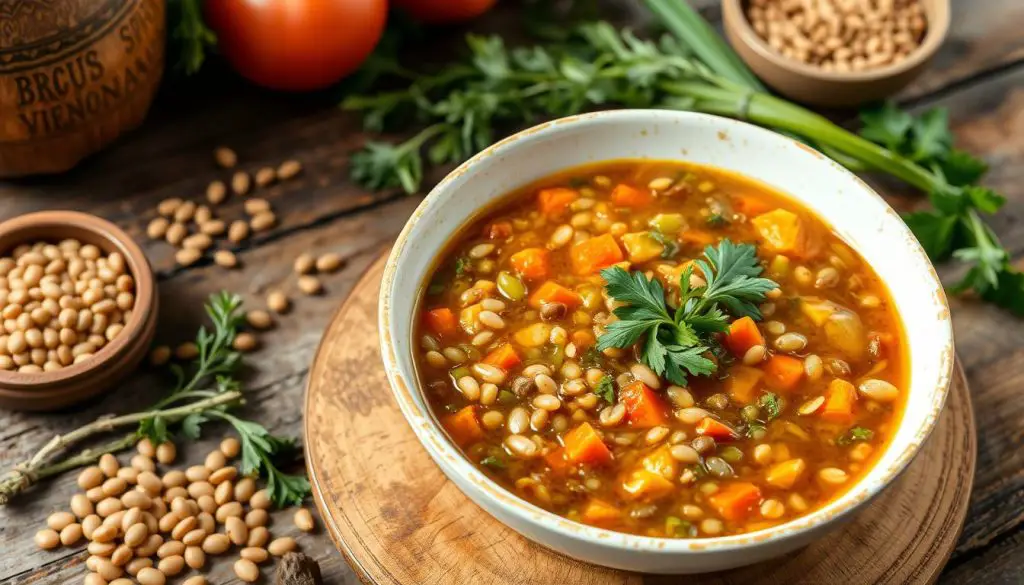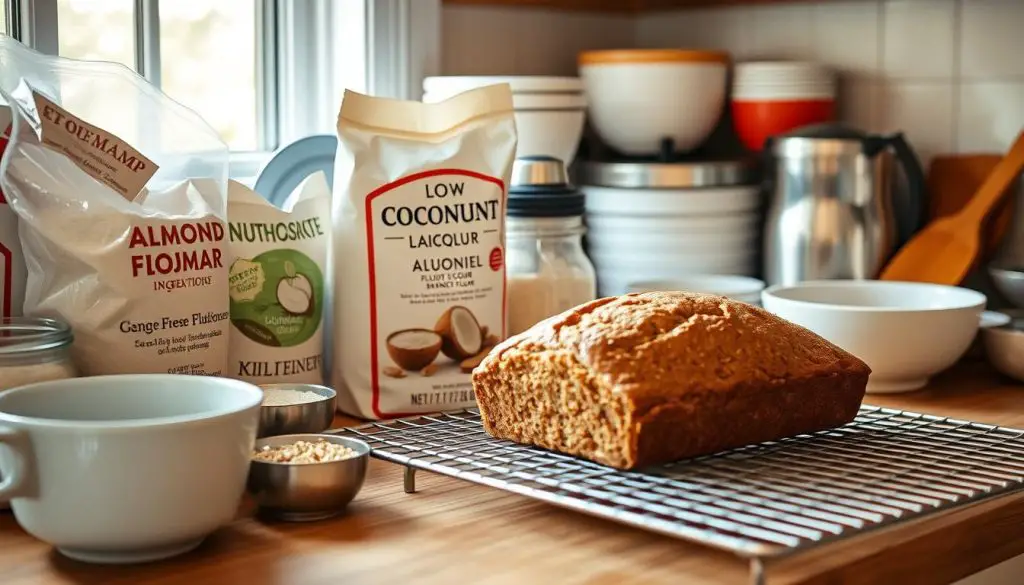Could a simple lentil soup help ease fibromyalgia symptoms? Surprisingly, following a low FODMAP diet may offer significant benefits. A recent study found that 58% of people over 60 have diverticulosis, a condition linked to dietary triggers that can worsen fibromyalgia. Yet, less than 5% of these individuals will develop diverticulitis, showing that a smart diet can make a big difference.
If you’re dealing with fibromyalgia’s widespread pain, fatigue, and other symptoms, this low FODMAP lentil soup could be a game-changer. It’s packed with anti-inflammatory ingredients and is gentle on your digestive system. This comforting meal may help ease your symptoms and boost your overall health. Are you ready to explore the power of a low FODMAP diet and change your fibromyalgia journey?
Understanding Fibromyalgia and Its Impact
Fibromyalgia is a complex condition with chronic pain, fatigue, sleep disturbances, and cognitive difficulties. Despite a lot of research, we don’t know what causes it. Many people and doctors are looking into dietary approaches for fibromyalgia to help manage symptoms.
Fibromyalgia: A Complex Condition with Widespread Pain
People with fibromyalgia have ongoing pain and tender spots. This pain makes everyday tasks hard. It also affects work and life quality. Along with pain, they often feel fatigue, sleep disturbances, and cognitive difficulties, making it even harder to manage.
The Search for Dietary Solutions
Researchers and doctors are looking into dietary interventions to help with fibromyalgia. They’ve studied diets like gluten-free, raw vegetarian, and low FODMAP. These diets might help, but we need more research to know for sure.
What is a Low-FODMAP Diet?
The low FODMAP diet helps people with irritable bowel syndrome (IBS) and small intestinal bacterial overgrowth (SIBO). It focuses on cutting down on certain carbs that cause stomach issues. These carbs are hard for some people to digest.
Eliminating Fermentable Carbohydrates
When starting the low FODMAP diet, you stop eating foods high in FODMAPs. This lets your gut heal and eases symptoms. Later, you add foods back in to see which ones make you feel bad.
FODMAP Food Categories and Reintroduction
- Foods are grouped into FODMAP categories like fructose, lactose, and more.
- By adding back each type of FODMAP, you find out what foods upset you.
- This method helps people with fibromyalgia and other gut issues find the right diet for them. It improves their gut health.
Benefits of a Low-FODMAP Diet for Fibromyalgia
Research shows that a low FODMAP diet can help those with fibromyalgia. It reduces the intake of fermentable carbs. This can ease symptoms like bloating, pain, and changes in bowel habits.
This diet may also help reduce inflammation and improve the gut-brain axis. Studies suggest it can positively affect pain and other symptoms of fibromyalgia. It’s believed to help with the complex relationship between gut health, inflammation, and the brain.
- The low FODMAP diet has a 75% success rate in managing IBS symptoms, which often go hand-in-hand with fibromyalgia.
- It can also help with conditions like autoimmune diseases, chronic fatigue syndrome, and fibromyalgia, which are linked to SIBO.
- The diet involves three stages: Restriction, Re-introduction, and Personalization. The goal is to find and avoid trigger foods while slowly adding more foods back into the diet.
The low FODMAP diet may improve symptoms and quality of life for those with fibromyalgia. It addresses gut issues and inflammation. Always work with a healthcare professional to safely start a low FODMAP diet.
It’s important to adapt the low FODMAP diet to local foods to make it easier to stick to. With the right help and adjustments, it can be a key part of managing fibromyalgia.
Low FODMAP Lentil Soup for Fibromyalgia
If you’re looking for a comforting meal that’s good for fibromyalgia, try this low FODMAP lentil soup. It’s packed with plant-based protein, fiber, and vitamins. The ingredients are easy to digest and the soup is gluten-free.
A Nutrient-Dense and Fiber-Rich Meal
This low FODMAP lentil soup is great for managing fibromyalgia. It’s full of nutrients that fight inflammation and boost your health. Lentils are also high in fiber, which helps with digestion and can ease fibromyalgia symptoms.
Ingredients and Preparation
To make this nutrient-dense and gut-healing soup, you’ll need a few simple ingredients:
- Brown or green lentils
- Carrots
- Celery
- Garlic-infused olive oil
- Vegetable broth
- Spices (such as cumin, paprika, and bay leaves)
To prepare the soup, start by sautéing the low FODMAP vegetables in garlic-infused olive oil. Add the lentils and vegetable broth, then simmer until the lentils are tender. Season with your desired spices, and enjoy this nutrient-dense, fiber-rich, and anti-inflammatory meal.

Exploring Other Low-FODMAP Recipes
There’s more than just low FODMAP lentil soup to enjoy. A world of tasty and healthy low FODMAP recipes can fit into a fibromyalgia-friendly diet. Try a low FODMAP chicken stir-fry for a mix of low FODMAP vegetables, lean protein, and a tasty sauce.
Low-FODMAP Chicken Stir-Fry
Stir-fries are quick and gut-friendly. This low FODMAP chicken stir-fry has sliced chicken breast, bell peppers, bok choy, and a delicious sauce. The sauce uses gluten-free soy sauce and rice vinegar. It’s a gluten-free dish full of nutrients for your health.
Discovering low FODMAP meal options can make your diet more interesting. It helps your gut health and overall well-being. From soups to stir-fries, there’s a lot of gut-friendly food to try.
Incorporating Low-FODMAP Foods into Your Diet
Following a low FODMAP diet helps manage fibromyalgia. Focus on adding wholesome, low FODMAP ingredients to your meals. Choose gluten-free grains like brown rice and quinoa. Also, include lean proteins such as chicken and fish.
Make sure to add plenty of low FODMAP vegetables like leafy greens and carrots. These nutrient-dense, gut-friendly foods help your body stay healthy. They also help manage fibromyalgia symptoms.
Wholesome Low-FODMAP Ingredients
Discover these low FODMAP foods for your diet:
- Gluten-free grains: brown rice, quinoa, millet, buckwheat, and oats
- Lean proteins: chicken, turkey, fish, eggs, and tofu
- Low FODMAP vegetables: leafy greens, carrots, bell peppers, zucchini, and cucumber
- Low FODMAP fruits: blueberries, strawberries, oranges, and bananas
- Healthy fats: avocado, olive oil, and nuts (in moderation)
Using these nutrient-dense, low FODMAP ingredients makes tasty meals. These meals support your health and well-being.

Tips for Starting a Low-FODMAP Elimination Diet
Starting a low FODMAP elimination diet might seem hard, but it can help manage fibromyalgia. It’s important to work with a healthcare provider or dietitian. They can help tailor the diet to fit your needs.
While on the elimination diet, watch your symptoms closely. Notice how your body reacts to different foods. This helps find out which foods trigger your symptoms. After the elimination, you can slowly add back high FODMAP foods. Keep track of how your body reacts to each one.
Following a low FODMAP diet can teach you a lot about your body and food. It helps you make choices that support your gut health and overall well-being. The reintroduction phase is key. It lets you create a diet that’s just right for you.
- Work closely with a healthcare professional to develop a personalized low FODMAP elimination diet plan.
- Carefully monitor your symptoms during the elimination phase to identify your trigger foods.
- Gradually reintroduce high FODMAP foods one by one, tracking your body’s response.
- Be patient and persistent – finding the right personalized approach may take time, but it’s worth it to improve your gut health and manage fibromyalgia symptoms.
Low-FODMAP Baking and Meal Prep Ideas
Following a low FODMAP diet gets easier with meal planning and prep. Try baking gluten-free breads, muffins, and cakes for tasty, gut-friendly treats. Also, make meals like lentil soup or chicken stir-fry ahead of time. This saves time and keeps you fueled with fibromyalgia-friendly recipes all week.
Adding low FODMAP baking and meal prep to your routine helps manage fibromyalgia. Spend a weekend cooking up gluten-free, time-saving meals. This way, your weekdays will be a breeze.
Batch Cooking for Convenience
Preparing meals in advance is key to sticking to a low FODMAP diet. Set aside a weekend to make big batches of your favorite dishes. Think:
- Lentil soup
- Chicken stir-fry with low FODMAP veggies
- Roasted sweet potato and quinoa bowls
- Baked salmon with asparagus
Divide these meals into portions and freeze or fridge them. This ensures you always have a healthy, fibromyalgia-friendly meal ready, even when you’re busy.
Low FODMAP Baking Made Easy
It’s easy to satisfy your baking cravings on a low FODMAP diet. Use gluten-free flours like rice or almond to make delicious treats. Try making:
- Blueberry muffins
- Banana bread
- Chocolate chip cookies
- Lemon pound cake
Having these low FODMAP and gluten-free baked goods ready means you can enjoy sweet treats without worrying about your fibromyalgia.

| Ingredient | Quantity | Tolerance Level |
|---|---|---|
| Whole wheat bread | 2 slices | Tolerated |
| Sourdough/French bread | 1 large slice or 2-3 smaller slices | Tolerated |
| Cooked apples | 1 cup | Tolerated |
| Greek yogurt | 1 serving (6 oz.) | Tolerated |
| Avocado | Any amount | Tolerated |
| Cashews, almonds, almond butter | Any amount | Tolerated |
| Beans, lentils | 1/2 cup beans, 1 cup lentils | Tolerated |
| Hummus | Any amount | Tolerated |
| Seitan | Any amount | Tolerated |
| Raisins | Moderate amounts | Tolerated |
Finding Support and Resources
Managing fibromyalgia and following a low FODMAP diet can be tough. It’s key to have support and knowledgable healthcare providers. Look into joining a fibromyalgia support group, online or local. This way, you can share experiences and learn from others.
Also, check out websites and apps like the Monash FODMAP app. They offer the latest on low FODMAP foods and recipes.
Working with your healthcare provider is also important. A rheumatologist or dietitian can help create a fibromyalgia management plan. They offer personalized advice and track your progress.
Online communities are another great resource. Join forums, Facebook groups, or other platforms for fibromyalgia and low FODMAP diets. You’ll find people who understand what you’re going through.
Don’t face this alone. Finding the right resources and building a support network can greatly improve your fibromyalgia management and overall health.
| Resource | Description |
|---|---|
| Monash FODMAP app | Provides up-to-date information on low FODMAP foods and recipes. |
| Fibromyalgia support groups | Local and online communities where you can connect with others and share experiences. |
| Registered dietitians | Healthcare providers who can help you develop a personalized low FODMAP diet plan. |
| Online forums and communities | Platforms where you can find support, advice, and resources for managing fibromyalgia and following a low FODMAP diet. |
Lifestyle Adjustments for Fibromyalgia Management
A low FODMAP diet is key for fibromyalgia management. But, other lifestyle changes are also important. This approach helps manage symptoms and improve well-being.
Sleep Hygiene is critical for fibromyalgia patients. A regular sleep schedule and a calm sleep space are essential. Good sleep hygiene can improve sleep quality and duration.
Stress Reduction methods like meditation and yoga are helpful. They reduce stress levels common in fibromyalgia. Adding these stress-reducing activities to your day can ease symptoms and boost well-being.
Physical Activity is important for managing fibromyalgia. Gentle exercises like walking or swimming can strengthen muscles and reduce pain. Start slowly to avoid worsening symptoms.
Mindfulness practices, like meditation, help with pain and stress. They make you more aware of your thoughts and feelings. This can lead to better pain control and overall well-being.
By focusing on sleep hygiene, stress reduction, physical activity, and mindfulness, you can manage fibromyalgia symptoms. This holistic approach improves your quality of life.

Combining Diet with Other Therapies
Managing fibromyalgia requires a multi-modal approach. This means combining dietary changes with other treatments. A low FODMAP diet can help, but works best with other therapies like medication and physical therapy.
Working with a healthcare team is key. They help create a treatment plan that tackles fibromyalgia’s complex nature. This approach recognizes that fibromyalgia needs a multi-faceted solution.
Recent studies show the benefits of combining diet with other therapies. Seven clinical trials looked into different diets. Five of these studies found improvements in symptoms like pain and fatigue.
For example, a low FODMAP diet cut fibromyalgia symptoms by 50%. Vegetarian and hypocaloric diets also showed great results. They improved scores on the Fibromyalgia Impact Questionnaire Revised (FIQR) and quality of life.
While these results are encouraging, more research is needed. But, the evidence supports a multi-modal approach. This includes diet, medication, physical therapy, and cognitive-behavioral therapy for managing fibromyalgia.
Fibromyalgia patients can work with healthcare professionals to create a personalized plan. This plan includes dietary changes and other therapies. It helps individuals find relief and improve their quality of life.
Ongoing Research and Future Directions
Scientists are diving deep into fibromyalgia, looking at how diet can help. They’re studying the low FODMAP diet, among others. This research aims to find better ways to treat fibromyalgia, focusing on the gut and brain connection.
Working together, doctors, researchers, and patients are key to making progress. They’re on a mission to improve life for those with fibromyalgia. This team effort is essential for finding new ways to manage the condition.
The link between the gut and brain in fibromyalgia is a big focus. Researchers want to understand how they interact. They hope to offer more tailored treatments, improving life for those with fibromyalgia.
As we learn more about fibromyalgia, better treatments are on the horizon. The future looks bright with ongoing research and teamwork. Together, we can make a big difference in the lives of those with fibromyalgia.
Source Links
- https://www.healthline.com/health/diverticulitis-diet-list-of-foods-to-avoid
- https://findinglifessilversun.com/tag/fibromyalgia/
- https://nourishingmeals.com/
- https://www.healthyfood.com/advice/food-fodmaps-and-ibs-what-to-eat-and-what-to-avoid/
- https://www.healthline.com/nutrition/elimination-diet
- https://nourishingmeals.com/diet/basic-elimination-diet
- https://revistas.proeditio.com/jonnpr/article/view/4274/PDF4274
- https://healthpath.com/sibo/what-is-the-best-diet-to-treat-sibo/
- https://www.healthline.com/health/crohns-disease/foods-manage-helen-marley
- https://desireerd.com/sibo-diet/
- https://www.avogel.co.uk/health/digestive-system/ibs/ibs-dos-and-donts/part-two/
- http://caseythecollegeceliac.blogspot.com/2020/12/61-healthy-gluten-free-dinner-recipes-made-30-minutes-or-less.html
- https://nourishingmeals.com/2010/01/elimination-and-detoxification-diet-its-about-feeling-good
- https://thehappypear.ie/general/how-to-improve-gut-health/
- https://www.theirritablevegan.com/how-to-manage-ibs-in-20-minutes-or-less/
- https://fodmapsdiet.wordpress.com/2012/11/12/my-definition-of-low/
- https://my.clevelandclinic.org/departments/wellness/patient-resources/recipes
- https://downshiftology.com/whole30-food-list-what-to-eat/
- https://thyroidpharmacist.com/articles/food-sensitivities-and-hashimotos/
- https://www.iafaforallergy.com/disease-a-to-z/irritable-bowel-syndrome-ibs-complete-guide/
- https://www.mamanatural.com/poop-chart/
- https://www.paincation.com/seeking-relief-from-fibromyalgia-through-diet-a-hopeful-path-in-a-sea-of-doubts-rss/
- https://www.mdpi.com/2072-6643/16/16
- https://healthpath.com/sibo/sibo-test-complete-guide/
